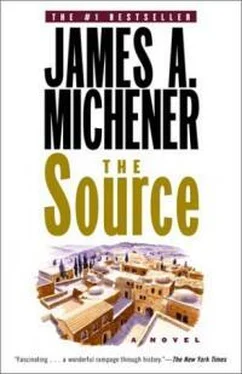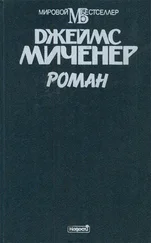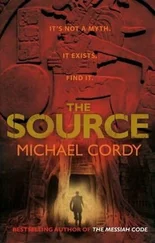3
The third Jew who made the long pilgrimage to Safed came not from raw fear, like Rabbi Zaki, nor from a love of Kabbalism, like Dr. Abulafia; he came impelled by a force greater than either of those: the moral outrage of a man disgusted by his society.
In 1523 Germany represented an anomaly among the nations: Spain, Portugal, France and England, as rising national states, had expelled their Jews; but Germany, not to be united for several centuries, found no way to act as a unit and so began to accumulate those historic hatreds that were to erupt so savagely in later periods. For example, Cologne had expelled its Jews in 1426 but Frankfort had not. Augsburg, Nuremberg and Ulm had banished their Jews long ago, but the Rhineland city of Gretz, secure within its wall, still preserved a Judenstrasse where Jews were permitted to exist; and no resident of that quarter was more respected than Rabbi Eliezer bar Zadok, a descendant of the great family Hagarzi ha-Ashkenaz, whose ancestors had come from Babylonia as groats makers about a thousand years before. In 1523 Rabbi Eliezer was a tall, scholarly man who surprised strangers with his boyish jokes and love of good beer. At his wedding to the prettiest Jewess in Gretz, Leah the weaver’s daughter, he astounded the Judenstrasse by dancing all night, drinking beer with any who would join him and then in the cold dawn leading a group of scholarly Jews to the synagogue, where he lectured on the Talmud till nightfall, never mispronouncing a word. Friends asked, “But what of the bride?” and he replied with an extraordinary smile, “Leah and I are married for eternity. One night spent dancing with friends, one day spent honoring the Talmud we shall never miss.”
He was the acknowledged leader of the Jewish community, the judge of the Judenstrasse. More than any other Jew in Gretz he was free to move about, and although he was forced to observe all normal laws governing Jewish quarters, he alone managed to accept them with a certain dignity. For example, although he was a tall man he was forced by law to wear a Jew-hat almost three feet high, conical in shape, red in color and with a brim twisted to form devil’s horns, so that when he moved about the city he could be identified as a Jew. He was also required to wear a coarse woolen coat “which must reach to within two inches of the earth,” and this gave him the figure of a witch and was an invitation for the rabble to chase him through the alleys; but Eliezer wore his coat with such dignity that on him it became a kind of uniform, honored by the man who wore it. In the middle of the coat’s back, like a target, was sewed a bright yellow ring signifying—as if additional signs were needed—that the wearer was a Jew, and the same ring, smaller in diameter, was repeated in front over the heart. It was this loathsome stigma that invited the Gentile community to despise even a dignified Jew like Rabbi Eliezer, for wherever he walked the yellow badge proclaimed, “Here comes a Jew!” The circle was interpreted by some to represent a coin, ridiculing the only profession allowed the Jews; but most knew it to be a reminder of the holy wafer used in communion, which Jews were accused of stealing to profane in their obscene rites. It was this symbol, more than any other infliction, which kept the Jew apart from honest people; and if boys threw stones at Jews, it was partly because the slowly moving circles made irresistible targets.
There were other irritations. Eliezer, as a rabbi, would normally have grown a long beard, but since beards were a sign of German respectability, he must keep his short. He was not allowed to walk near the cathedral, to be on the streets during Holy Week, to converse aloud where others could hear him during church services, or halt at any time to speak with children lest he lure them into apostasy. Worst of all, he was required both by law and by custom to live within the Judenstrasse, which in Gretz was a concentrated horror. In the twelfth century two rows of large houses had been erected for Christians, and because enmity had developed between the owners, a space was left between the rows, and here brawls used to occur. The authorities were forced to build two walls sealing the houses off from each other, thus creating an empty space, forty-four feet wide, into which had been squeezed two rows of Jew houses along an alley six feet across. On the street level the houses seemed almost to touch; but as more and more Jews were crowded into the area, each narrow house had to be built higher and higher until finally only a small section of sky was visible: the Judenstrasse was permanently in shadow, its rooms gasping for air and its inhabitants crowded beyond belief.
One end of the street was blocked by a house which rose five stories, cutting off the sun, while the other was guarded by a stout iron gate, above which rose another house, so precious was the space. Thus the narrow area was closed at all points, and at dusk each day the iron gate clanged shut to be locked by a Christian guard whose salary the Jews were forced to pay. Inside the gate, where each Jew must see it daily, rose an obelisk commemorating a crime supposed to have been committed by the Jews of Trent some years before. Each of the four sides contained bas-reliefs showing details of how a saintly child had been tortured to death by hideous Jews in long cloaks, while above ran the legend: “Sacred to the memory of the Christian boy, Simon of Trent, whose body was used as a blood sacrifice by the Jews of that city in the year 1475, for which unnatural crime all the Jews of Trent were burned to death.” It was a solemn reminder of the volcanic passions that might erupt at any moment against Jews, made more poignant by the fact that sometime after the mass burning, it was proved beyond question that Simon had not been touched by the Jews, and that the whole affair must be excused as another unfortunate mistake.
In each narrow room of the Judenstrasse lived an average of six persons, so that the number of Jews in the city was not insignificant, but they were not allowed to work in the Christian areas of the city, nor to join any of the guilds where men worked as artisans, nor to buy or sell merchandise of any kind except amongst themselves, nor to engage in any kind of enterprise except moneylending, which the Church still forbade to Christians; and it was not unusual to see the Christian dignitaries of Gretz come furtively to the Judenstrasse money shops, seeking loans, and then some months later to lead the rabble in to kill the moneylenders, burn the account books, and thus erase all debts.
Apologists for the system pointed out: “Having the Jews assembled in one place affords them protection in case of trouble,” and perfectly sincere Christians who had never seen the incredible conditions believed this. They also argued: “Jews like to live in a Judenstrasse. They thrive on it, don’t they?” This reasoning was, in a perverse way, proved true by the Jews themselves, for when they found their families crowded into loathsome quarters, they adhered even more stringently to their strict sanitary laws, and at the same time Jewish medicine, which Christians ambivalently scorned and sought, protected them from many of the plagues which swept the free population. The Talmud itself had said: “No Jew may live in a city that lacks a good physician.”
In the middle of the Judenstrasse stood one narrow room, musty and cramped, the center of Rabbi Eliezer’s joy. It was his synagogue, and few houses of God have ever been so mean as this ugly little hovel in which the Jews of Gretz were forced to worship; it had no benches, no windows, no shelves for manuscripts. Jews who wished to pray sat on the floor, or, when the room was crowded, stood. There was a raised desk from which on Shabbat the rabbi’s uncle, Isaac Gottes Mann, read the Torah, and there was one small shred of adornment: in front of the cupboard where the scroll of Torah was kept, hung an embroidered cloth. And that was about all, except that in one corner, for use on weekdays, there stood a patched and rickety table more than a hundred years old, plus one chair and a candelabrum; it was here, day after day through the long years, that Rabbi Eliezer studied Talmud, endeavoring to identify the legal and moral bases of his faith. Among the Jews of Germany it was recognized that if he were permitted long life he must surely become one of Judaism’s luminaries.
Читать дальше








![Джеймс Купер - Пионеры, или У истоков Саскуиханны [The Pioneers, or The sources of the Susquehannah]](/books/395797/dzhejms-kuper-pionery-ili-u-istokov-saskuihanny-t-thumb.webp)

